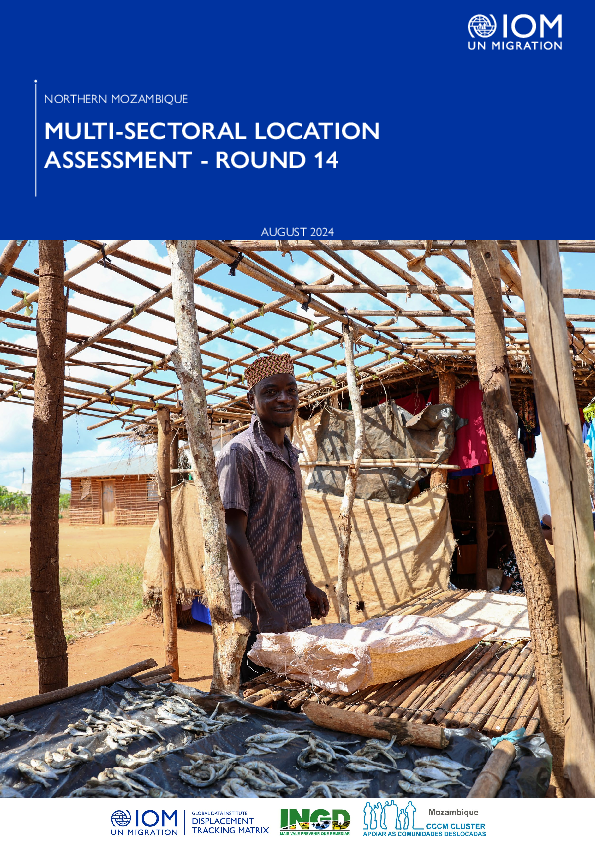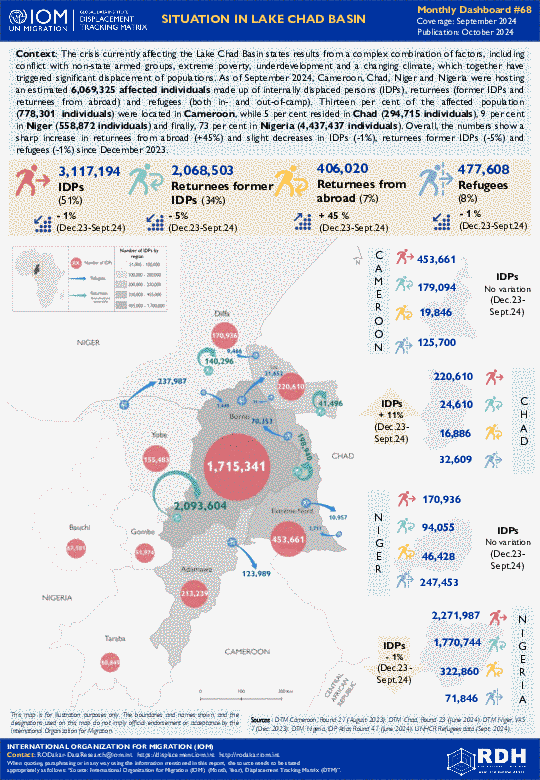-
Countries
-
Data and Analysis
-
Special Focus
-
Crisis Responses

Contact
dtmhaiti@iom.int
Language
English
Location
Haiti
Period Covered
Oct 03 2024
Oct 09 2024
Activity
- Mobility Tracking
- Event Tracking
This information was gathered following attacks that occurred on 4th October in the municipality of Saint Marc, in the 5th communal section of Bocozelle, precisely in the locality of Pont-Sondé. This report is an update of the one that was published on 4th October (ETT 49). A total of 6,742 individuals (1,414 households) were displaced as a result of these attacks. These individuals sought refuge in the municipalities of Saint Marc, Montrouis, Verretes, La Chapelle and Petite Rivière de l'Artibonite, with 78% of them staying with relatives as host families, while 22% in 6 separate sites including 3 sites that was opened at the beginning of displacement and 3 created after the publication of the first report on this situation.
As of September 2024, 3,187,793 individuals have been displaced, including 2,616,570 internally displaced persons (82% of the displaced population) and 571,223 refugees (18% of the displaced population). Sixty-six per cent of the displaced populations (2,101,962 individuals) were located in Burkina Faso, while 14 per cent resided in Mali (451,844 individuals), 11 per cent in Niger (352,718 individuals) and 4 per cent in Mauritania (136,954 individuals). The crisis’ recent spill over to coastal countries, namely Côte d’Ivoire, Ghana, Togo and Benin, shows growing number of refugees coming from the Central Sahel and populations internally displaced. As of September, 144,315 individuals were affected by displacement within the four countries (25,929 in Benin, 59,937 in Côte d’Ivoire, 7,242 in Ghana and 51,207 in Togo) of which 34,088 were internally displaced.
As of September 2024, Cameroon, Chad, Niger and Nigeria were hosting an estimated 6,069,325 affected individuals made up of internally displaced persons (IDPs), returnees (former IDPs and returnees from abroad) and refugees (both in- and out-of-camp). Thirteen per cent of the affected population (778,301 individuals) were located in Cameroon, while 5 per cent resided in Chad (294,715 individuals), 9 per cent in Niger (558,872 individuals) and finally, 73 per cent in Nigeria (4,437,437 individuals). Overall, the numbers show a sharp increase in returnees from abroad (+45%) and slight decreases in IDPs (-1%), returnees former IDPs (-5%) and refugees (-1%) since December 2023.
As of September 2024, 3,991,898 individuals were affected, including 455,533 internally displaced persons (12% of the displaced population), 2,256,970 returnees former IDPs (56%), 531,919 returnees from abroad (13%) and 747,476 refugees (19%). In the CAR, the largest displaced population consists of former IDP returnees. Refugees from the CAR are primarily hosted by Cameroon (308,891 individuals, or 44% of the refugees), the Democratic Republic of the Congo (DRC) (208,484 individuals, or 30% of the refugees) and Chad (138,542 individuals, or 20% of the refugees). Nonetheless, 11,008 refugees from the Central African Republic are still living in Sudan (2% of the refugees). The country is also home for refugees from neighbouring countries, hosting a total of 43,393 refugees coming from Sudan (29,070 individuals), the DRC (6,505 individuals), Chad (4,951 individuals) and South Soudan (2,867 individuals).

Contact
dtmlebanon@iom.int
Language
English
Location
Lebanon
Period Covered
Oct 10 2023
Oct 09 2024
Activity
- Mobility Tracking
- Baseline Assessment
Since October 8 there has been an increase in cross-border incidents between Israel and Lebanon, resulting in the displacement of people both within the South and elsewhere within the country. Since October 10, the Displacement Tracking Matrix (DTM) has been conducting the daily monitoring of population movements. The objective of the exercise is to inform preparedness and response planning.

Contact
DTMAfghanistan@iom.int
Language
English
Location
Afghanistan
Period Covered
Sep 29 2024
Oct 05 2024
Activity
- Survey
- Flow Monitoring Survey
- Flow Monitoring
DTM Flow Monitoring, conducted by IOM Afghanistan, is designed to provide insights into the mobility patterns at Afghanistan’s border points with the Islamic Republic of Iran and Pakistan. This activity involves two interlinked exercises: Flow Monitoring Counting (FMC), which monitors the number of movements across the border, and Flow Monitoring Surveys (FMS), which collect data on the profiles of randomly selected Afghan nationals crossing the border including documentation held, reasons for travel, and the intended period of stay/ travel. It is important to note that DTM collects information on total movements at a given border point, not the number of unique individuals entering or leaving the country. As a result, if one individual both left and re-entered Afghanistan during the reporting period, this would count as one outflow movement and one inflow movement. Movements can be attributed to a wide variety of reasons, including returnees coming back to Afghanistan after living abroad, people visiting family, deportees, those travelling for economic reasons, medical patients, students, or Afghans moving abroad for different reasons. Circular movements, which include those who frequently and regularly travel back and forth across the border for trade and other reasons, are also common. This monitoring offers a clear picture of population movements in and out of the country.
DTM FM is operational at four main crossing points (connected to Afghanistan’s National Highway) as well as six other crossing points with Islamic Republic of Iran and Pakistan. This weekly snapshot combines information from the FM activity and various IOM sources related to cross-border movement. For a detailed explanation of the methodology used in gathering this data, the report directs readers to the section titled “IOM INFLOW DATA” on the last page.

Contact
DTMPakistan@iom.int
Language
English
Location
Pakistan
Period Covered
Sep 16 2024
Sep 30 2024
Activity
- Flow Monitoring
The International Organization for Migration (IOM) Pakistan’s FM provides key insights into the overall migration trends of Afghan nationals returning to Afghanistan, as well as an overview of the profiles of Afghan returnees and their mobility patterns, exploring routes, vulnerabilities, demographics and social characteristics. Between 16 and 30 September, DTM border monitors (BMs) interviewed 473 heads of households through a Flow Monitoring Registry (FMR) form, while 10,657 Afghan returnees were identified through five border crossing points.
HIGHLIGHTS
- During this reporting period, DTM teams have observed a decrease of 11 per cent in returns compared to the first two weeks of September 2024.
- Cumulatively, from 15 September 2023, 734,817 individuals have returned to Afghanistan. Thirty-three per cent (243,926 individuals) of this total have returned since 1 January 2024.
- Most of the returnees are undocumented Afghans (80%), followed by PoR holders (18%) and ACC holders (2%).
- Compared to previous reporting periods, more returning Afghan nationals were identified as vulnerable (3%).

Contact
DTM Mozambique, DTMMozambique@iom.int
Language
English
Location
Mozambique
Period Covered
May 15 2024
Jun 05 2024
Activity
- Mobility Tracking
- Site Assessment
The Round 14 MSLA assessed 103 sites across Northern Mozambique, identifying a total of 214,576 internally displaced persons (IDPs). This represents a nine per cent increase from the previous round, with displacement driven primarily by ongoing insecurity in Cabo Delgado. While these figures focus on those residing in designated sites, it is important to note that many displaced individuals are also living within host communities, as reported in the DTM Round 21 Mobility Tracking Report. The assessment covered a range of site types, including relocation sites, resettlement sites, temporary sites or transit centers, and host community extensions. The findings provide a comprehensive overview of the demographic breakdown of IDPs, their vulnerabilities, and the specific sectoral needs across shelter, water, sanitation and hygiene (WASH), food security, health, education, protection, and community engagement.
Key findings reveal that 55 per cent of the IDP population are children (under 18), with significant challenges in shelter, food security, and access to essential services. The data underscores the importance of targeted humanitarian interventions to address the ongoing and dynamic displacement situation in Northern Mozambique.
This report focuses on youth “on the move” to Europe by sea and by land, a population category that includes adolescents (children between 14 and 17 years old) and young adults (18-24 years old). It highlights the profiles, needs and challenges faced by these age groups during their mixed migration journeys to Europe, by using the International Organization for Migration's (IOM) Displacement Tracking Matrix (DTM) Flow Monitoring Surveys (FMS) conducted in 2023 in Albania, Bosnia and Herzegovina, Greece, Italy, Montenegro, North Macedonia, Serbia, Spain, Kosovo*.

Contact
DTM Mozambique, DTMMozambique@iom.int
Language
English
Location
Mozambique
Period Covered
May 15 2024
Jun 05 2024
Activity
- Mobility Tracking
- Site Assessment
The Round 14 MSLA assessed 93 sites across Central and Southern Mozambique, identifying a total of 136,637 IDPs. This represents a 14 per cent increase from the previous round, with displacement driven primarily by climatic shocks. While these Figure focus on those residing in designated sites, it is important to note that many displaced individuals are also living within host communities, as reported in the DTM Round 21 Mobility Tracking Report. The assessment covered a range of site types, including relocation sites, resettlement sites, temporary sites or transit centers, and host community extensions. The findings provide a comprehensive overview of the demographic breakdown of IDPs, their vulnerabilities, and the specific sectoral needs across shelter, water, sanitation and hygiene (WASH), food security, health, education, protection, and community engagement.
Key findings reveal that 50 per cent of the IDP population are children (under 18), with significant challenges in shelter, food security, and access to essential services. The data underscores the importance of targeted humanitarian interventions to address the ongoing and dynamic displacement situation in Central and Southern Mozambique.




